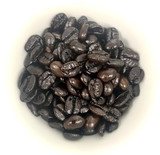Moisture, Expansion, and a Misleading Illusion

Picture this: You stop by a bakery stand to grab some whoopie pies. Although they're the same price, one is slightly bigger than the other. Whether you need those extra calories or not, aren't you more likely to grab the bigger one? After all, isn't it more of a bargain? Although the above scenario isn't strictly related to what I'm about to compare, keep it in mind as you read further.
If you see a variety of my coffee on a shelf at a store or stand, wouldn't you be more likely to grab the bag with more coffee? If you're a dark roast fan, that principle may benefit you; however, it may be disappointing if you prefer light roasts. A 16 oz. bag of a light roast will appear less filled than a 16 oz. bag of a dark roast, but why? In short, weight loss and expansion.
Green unroasted coffee beans have roughly an 11% (+/- 2%) moisture content, and as they dry, moisture in the beans rapidly evaporates. Additionally, the bean progressively deteriorates structurally and loses its silverskin. As a result, the roasted coffee loses a significant amount of weight. My Tanzanian light roast loses about 14% of its initial weight (1,600g to 1,380g), and my Nomads Italian roast (super dark) loses up to 25% (1,600g to 1,225g). If two batches of the same beans were roasted to different levels, the more lightly roasted bean would weigh more than the darker bean. To compensate, more darkly roasted beans must be used to reach the labeled packaging weight, therefore taking up a higher volumetric space than a light roast.
Although weight loss is the main reason for the finished product's volumetric increase, expansion is an essential secondary factor. Once the first phase, drying, is complete, the beans are yellow and smell like fresh hay. Their size is relatively unaffected, and they continue to gain heat as the Maillard phase begins. In this phase, the bean turns brown as amino acids and sucrose break down. They begin to smell sweet and like tangy maple syrup. As the development phase kicks off, the beans start to crack, audibly and physically, which indicates that the bean can no longer handle such heat without expelling it. The beans expand, sucrose begins to caramelize, and thousands of chemical reactions continue. The longer the beans go through the development phase, the more they'll lose structural integrity and the more they'll grow in size. Suppose the beans are taken beyond the "second crack" to 500 degrees Fahrenheit, an Italian Roast. They'll be about 35% ash, close to spontaneous combustion, and a dark brown/black color. African beans are small and dense, so when roasted light, the bag is nearly half full (or half empty, depending on your perspective). The same coffee stretched to an Italian roast fills the bag to the zipper, essentially to the point of me being unable to fit it in.
A small note worth mentioning is that although there is less volume with a light roast, the beans I use for them are typically more expensive per pound. By taking less coffee to reach the designated weight, I can avoid up-charging for the price increase handled on my end.
In summary, every CCR bag you see on a shelf is filled to at least the net weight specified on the label. Some bags seem half full, yet some are packed full to the brim. If you get a less-filled bag, you're not being shorted; the coffee you chose doesn't take up as much space as the others. Many factors go into roasting, but the two that affect the product's end volume are moisture loss and expansion. There's more science to be discussed regarding weight loss and its effect on brewing by weight vs. by volume, but that will be for a future blog post. Buy coffee based on your taste preference, don't let the size difference throw you off, and feel free to reach out on the "contact us" page if you have any questions about coffee!

From left to right: Tanzania green coffee, Tanzania light roast, and the Nomads Blend.
